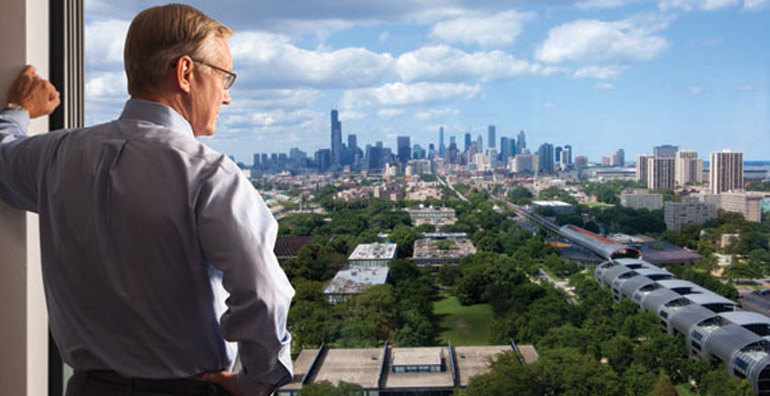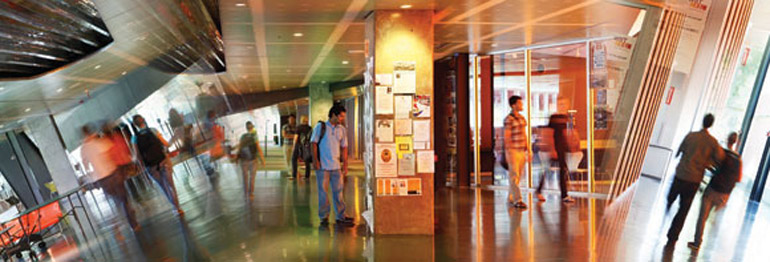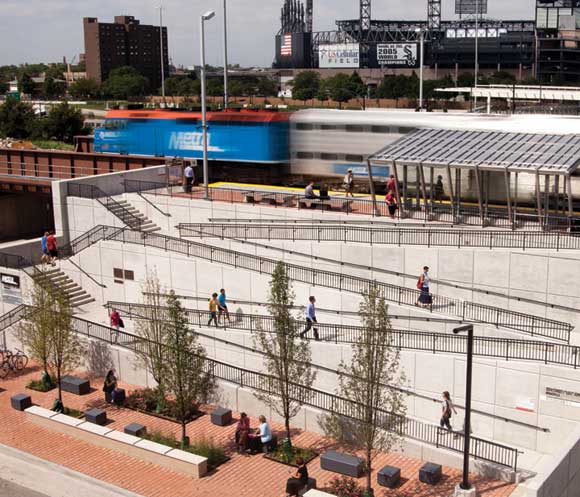
Photo: Michael Goss
Now that Richard M. Daley has left City Hall after a 22-year term as Chicago’s mayor, perhaps he’ll spend some time retracing his steps, recalling the Chicago that he knew when he became mayor in 1989.
He’d hardly recognize the corner of State Street and 35th Street.
That intersection, and the rest of the IIT campus, is radically, positively different than when Daley took office. The university has been transformed during his tenure, beginning the year he took office, when IIT received an $8 million grant to transform its campus and neighborhood. That touched off two decades of exceptional growth, and now there is brimming confidence and surging optimism on campus.
Here’s how IIT has changed.
Vibrant Campus

Photo: Michael Goss
Certainly, if you’re describing the changes to IIT’s Main Campus, you have to include the extraordinary buildings: the Helmut Jahn-designed student residence, State Street Village (2003); The McCormick Tribune Campus Center, designed by Rem Koolhaas (2003); and the renovation of Ludwig Mies van der Rohe’s landmark S. R. Crown Hall (2005).
But the transformation of IIT isn’t only physical, it’s cultural. At SSV, the entryways are punctuated by the contrast between corrugated metal and birch trees—not to mention an array of flyers promoting student activities and organizations. The bold colors and angles of MTCC are striking, but what really grabs your attention is that hundreds of students are on hand at lunchtime. Some are spinning records at campus radio station WIIT, some are setting up trick shots on pool tables, while others are meeting in conference rooms or working at computer stations. At Crown Hall, the renovation has revitalized Mies’ original architecture and makes the interior more visible to passersby, allowing them to see not only the building’s glass-and-steel facade, but also the student projects inside.
One reason that Main Campus is more active is there are more students: 2,437 full-time undergraduates in fall 2010, up from 1,794 in 1991. The shift is even more dramatic among graduate students, with 2,221 full-time grad students on Main Campus in fall 2010, compared to 546 two decades ago. (Fall 2011 enrollment figures were unavailable as of press date.)
“More people want access, and more people want to be social,” says Angela Ng (CE ’11), outgoing president of the student activities organization Union Board, which weighs event requests from more than 100 student organizations.
Walk through campus on a spring afternoon and, as you enjoy the new landscaping, you’ll probably also have to dodge Frisbees—the disc golf course can draw a crowd, as can Ultimate Frisbee games at Siegel Field.
“The growth we’ve had is fantastic; some of the changes that have happened on campus in the last few years have been hugely successful,” says Brian Kibbe (MMAE 5th year), former student body president. He says the task now is to make on-campus activities a focal point of the IIT experience.
Transformed Community

Photo: Michael Goss
In 2001, police served as escorts for David Baker and the Chicago Housing Authority (CHA) Board up 17 unlit flights of stairs in the Stateway Gardens projects adjacent to IIT. It was clear to Baker, IIT’s vice president for external affairs, that this was no way to live, and that there had to be a better alternative.
Ten years later, the buildings are gone. They’ve been replaced by a mixed-use, mixed-income development that includes condos, duplexes, and single-family homes where CHA residents live alongside professionals and IIT students. Three staples of college-town retail businesses have also opened on 35th Street: a coffeehouse, a sandwich shop, and a pizza place. (According to IIT Vice President for Community Affairs and Outreach Programs Leroy Kennedy, Mayor Daley himself stood in IIT Tower a decade ago, pointed down at the intersection, and proclaimed that it should have a Starbucks; now it does.)
IIT graduate students Tabitha Ponte and Bobby Zylstra are sitting by the windows in the Starbucks that now stands at the corner, reviewing plans for their nonprofit named 26Lab, which trains high school students in architecture, engineering, and construction by putting them to work on real-world projects in Bridgeport and Bronzeville. IIT’s Idea Shop hosted the pilot program.
There is still plenty of need, as well as plenty of opportunity, to serve in this neighborhood. But Ponte and Zylstra agree that the community already has changed to the extent that they feel they can make a difference—as opposed to, say, a decade ago, when the buildings at the south end of campus were damaged from spillover violence from the public housing projects, and Baker encouraged students not to venture too close to 35th Street.
Now, the area “is on the brink of significant transformation,” Ponte says. One milestone came in 2000, when the City of Chicago relocated its police headquarters to 3510 South Michigan Avenue. Another came in 2007, when the demolition of the Robert Taylor Homes public housing towers was completed.
IIT has also reached out to its neighbors by building relationships with community organizations and supporting initiatives such as 26Lab. The university also helps to run a charter middle/high school, the Perspectives/IIT Math and Science Academy.
For Baker, it has been a rewarding journey as he and IIT’s leaders have gone from “wringing our hands about our location” in the 1990s to now excitedly envisioning the next steps for the revitalization of Bronzeville, Bridgeport, and the campus itself. It has been a collective effort between the campus and community, and the university has spearheaded numerous projects to enhance local parks, homes, schools, and roadways.
Longtime residents have noticed the change as well. The neighborhood is “a melting pot, and [the physical changes] have stirred it very effectively,” says Leonard McGee, president of the Gap Community Organization, noting that IIT students and faculty are much more visible east of campus nowadays. He says the community has a ways to go, but is on the right track: “We’re moving down the road. We’re not moving real fast yet, but we’re moving down the road, and I think there is a genuine commitment on [IIT’s] part to be even more involved and more engaged.”
Baker agrees: “It’s been a radical change. We’ve transitioned to the point where now the only question is, ‘What is this neighborhood going to grow up to be?’”
Sustainable Campus
“In a couple of years, [a green campus] will be a litmus test,” says Joseph Clair (M.S. MAE ’95), IIT’s director of campus energy and sustainability. “Colleges will have to meet a certain standard to be considered by students of this generation.”
IIT is on pace to far exceed that baseline.The Princeton Review rated IIT one of the two greenest university campuses in Illinois last year. Campus projects range from an award-winning recycling program to a food-composting program, to bicycle rental stations that arrived in the spring, and 10 electric-vehicle charging stations.
Other eco-friendly initiatives apply IIT’s engineering focus to advancing sustainable technologies. Most prominent among these is Perfect Power, a joint project of IIT and the U.S. Department of Energy that is replacing the power grid on campus with a series of micro-grids that will be more efficient and more reliable. The first of four phases is complete, and project leaders estimate that the university will save between $500,000 and $1.5 million annually on its energy bills. Perfect Power also will benefit the IIT graduate students who have the opportunity to research the system.
The university also installed a small wind turbine next to Stuart Field at the north end of campus in July so that engineers can study its operation and reliability.
Clair believes the greening of Main Campus also reflects a growing sense of connection between the university community and its surroundings.
“People are taking care of the neighborhood and the campus, and people take care of things when they feel a sense of ownership. As an alum, my sense is that IIT seems to care more about being here than it used to,” he says.
Energized Business
David Hacker is looking for dead spots at the southern edge of IIT’s Main Campus at 35th and State streets. Once upon a time, it would have been easy enough; back then, IIT’s students and faculty didn’t often venture to this corner, which it shared with the Chicago Housing Authority’s Stateway Gardens projects. But now, the area is bustling with the activity of students, shoppers, homeowners, and even the employees of high-tech businesses at IIT’s tech-business incubator, University Technology Park.
Hacker is the director of engineering for ProOnGo LLC, a software company that makes an expense-tracking app for mobile phones. And the dead spots he’s seeking aren’t visual, but instead are gaps in the cellular network: He’s testing a new version of the ProOnGo app for BlackBerry.
The company moved to IIT in 2008. Chief Executive Officer Phil Leslie chose the location even though he isn’t an IIT grad. He was drawn to UTP because its proximity to campus provided him access to the skilled programmers who study at IIT. At any given time, ProOnGo employs from two to seven IIT graduate students, offering them a chance to write the code behind the apps in the phones of ProOnGo’s 250,000 registered users.
“We get to be the center of attention here a little bit, and that’s fun,” says Leslie. “Our interns are pumped to be able to write iPhone code that ships to real customers. It’s a matter of pride.”
ProOnGo is just one of the businesses based at UTP. The biotech firm Chromatin, Inc., which has raised more than $10 million in funding, is also there. Cleversafe, Inc., a cloud security firm, grew from three to 35 employees while at IIT; now based in downtown Chicago, the company raised $31.4 million in funding last year.
Connection to Chicago

Photo: Michael Goss
There are several compelling views from the platform at the new Metra stop adjacent to IIT’s Main Campus. Look east, and you can see the shops of Park Boulevard, the mixed-use residential and retail development at 35th and State streets. Look west, and you can see the outfield bleachers at U.S. Cellular Field, home of the Chicago White Sox. South, you can see down the Dan Ryan expressway for what seems like halfway to Indiana. The northern view, of course, is of Chicago’s skyline.
The cumulative, panoramic impression is of a campus that is ideally situated within a developing neighborhood and a world-class city. Already, the State Street bus and two recently renovated “El” lines (Red and Green Lines) run through the heart of campus. The Dan Ryan also makes Main Campus easily accessible by car.
Now the Metra, a commuter train, provides an even faster mode of transportation to campus from the suburbs. The new Metra stop, which opened in April, “confirms that IIT is one of the most conveniently located urban universities in the country,” according to Vice President for External Affairs David Baker. “We have gone from being perceived as an outlier in the 1990s to now being in the center. People are realizing, ‘Wow, it’s so easy to get [to IIT] from anywhere in the city.’ This Metra stop is the next step.”